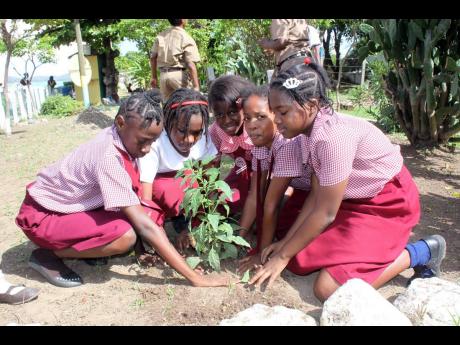The science and art of tree planting
During the early 1980s, I had the opportunity of participating in a tree-planting exercise along with then Mayor of Atlanta Andrew Young and members of the Y's Men Club. These trees were planted at the headquarters of the YMCA in Half-Way Tree, St Andrew. Unfortunately, none survived. It is within this context and reflecting on why we often experience failure in our efforts at tree planting that I share some thoughts on the science and art of planting trees.
Tree planting is both a science and an art, requiring a deep understanding of ecological principles, soil science, and horticultural techniques. The science of tree planting involves selecting appropriate species, understanding soil health, and managing pests and diseases while the art of tree administration focuses on the ongoing care and management of trees in urban and rural environments.
SCIENCE OF TREE PLANTING
Choosing the right tree species for a specific location is critical. This decision is based on several factors, including climate, soil type, water availability, and the specific needs of the local ecosystem. Native species are often preferred because they are well-adapted to the local environment and support local wildlife.
SOIL HEALTH
Healthy soil is the foundation of successful tree growth. This involves understanding soil composition, pH levels, and nutrient content. Soil tests can determine whether amendments such as compost, lime, or gypsum are needed to optimise conditions for tree growth.
SITE PREPARATION
Proper site preparation is crucial for young trees. This includes removing competing vegetation, ensuring adequate drainage, and digging a hole that allows for root expansion. The soil around the tree should be gently packed to avoid air pockets but not so compacted that it restricts root growth.
PLANTING TECHNIQUES
The actual planting process involves placing the tree in the ground at the correct depth, ensuring that the root crown is just above the soil line. Mulching around the base helps retain moisture and regulate soil temperature but should not touch the tree trunk as it can cause rot.
WATERING
Newly planted trees need constant watering to establish roots. Drip-irrigation systems are often used to deliver water directly to the root zone, which minimises evaporation and runoff.
ART OF TREE ADMINISTRATION
Pruning
Pruning is essential for the health and aesthetics of trees. It involves removing dead or diseased branches, shaping the tree, and improving air circulation within the canopy. Different tree species have specific pruning needs. Some benefit from winter pruning while others fare better with spring or summer interventions.
Pest and Disease Management
Effective tree administration requires vigilance in monitoring for pests and diseases. Integrated Pest Management strategies are often employed, combining biological controls, cultural practices, and, when necessary, chemical treatments to manage threats with minimal environmental impact.
Fertilisation
Fertilising trees can support growth and health, especially in nutrient-poor soils. Each tree¹ species has specific nutrient requirements that must be met to optimise their health. Overfertilization can be harmful, leading to nutrient imbalances and environmental pollution.
Urban Forestry
Managing trees in urban environments presents unique challenges. Urban foresters must consider the impacts of pollution, limited space, and human activity. Strategies include selecting tree species that are resilient to urban stressors, ensuring proper spacing and using innovative planting techniques such as structural soils and green roofs.
Community Engagement
Tree administration also benefits from community involvement. Educational programmes, volunteer tree-planting events, and citizen science projects can help foster a sense of stewardship and ensure the long-term success of urban forestry initiatives.
Technology Integration
Modern technology plays a role in tree administration, too. GIS mapping tools, remote sensing, and tree-inventory software can help arborists monitor tree health, plan maintenance activities, and respond to emerging threats promptly.
The science of tree planting and the art of tree administration are intertwined disciplines that require both technical knowledge and creative problem-solving. Successful tree planting provides immediate and long-term ecological, economic, and social benefits, from carbon sequestration and habitat creation to aesthetic enhancement and community well-being. By marrying scientific principles with thoughtful management practices, we can ensure that our urban and rural landscapes thrive for generations to come.

